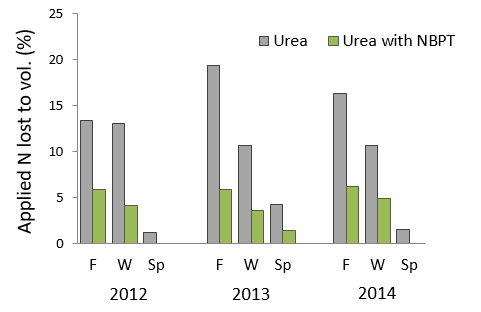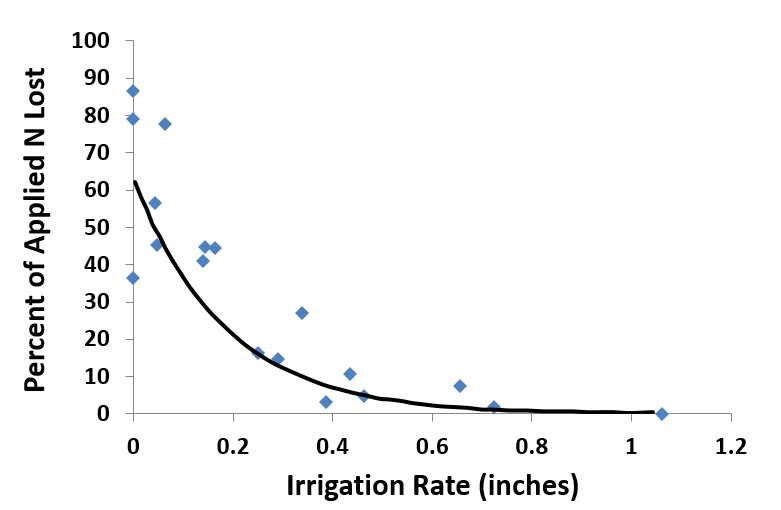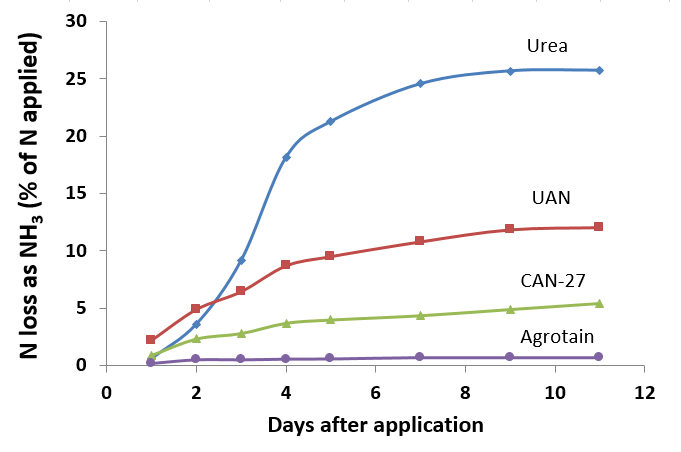Reducing N Fertilizer Loss to Air

Fig. 1. Nitrogen loss from urea broadcast in fall
and winter can be higher than from spring broadcast.
Adding NBPT to urea reduces the loss (R. Engel
unpub. data).
Nitrogen fertilizer costs are always a concern to producers. Management practices that minimize ammonia volatilization (loss of N to the atmosphere) allow producers to get the most out of nitrogen (N) fertilizer dollars. These practices can increase yields, protein and profit.
Ideally, ammonia and ammonium based fertilizers, including urea, are applied shortly before peak plant growth. However, this may not always be practical; therefore, urea is often applied in fall or winter.
Unfortunately, N loss to volatilization can be substantial from urea applied during fall and winter (Figure 1). MSU field trials found up to 44% of the applied N could be lost from urea broadcast between October and April, with an average loss of 18%. Losses were highest when urea was surface broadcast on a moist surface, including snow, with no rain or only sprinkles for the following 2 to 3 weeks.

Fig. 2. Percent of N lost to volatilization from
urea broadcast on a moist wheat field is reduced as
irrigation amount increases within a couple of hours
after application. Holcomb et al. 2011.
If at all possible, urea should not be broadcast in situations that promote significant volatilization (see High risk conditions text box). Incorporating urea within 1 to 2 days after application with equipment or irrigation can reduce losses. Applying urea immediately in front of airdrills does not provide enough incorporation to decrease volatilization. In place of tillage, a ½-inch irrigation or rainfall event is needed to move urea deep enough into the soil to minimize volatilization (Figure 2). Such rain events are not very common or predictable in dryland production. Furrow irrigation may exacerbate urea’s volatilization by dissolving urea without pushing it down into the soil.
High Risk Conditions for Urea Volatilization
- Moist soil, heavy dew, or high humidity
- Little precipitation in forecast
- Wind
- High soil pH (>7.0)
- High soil temperature (>50 °F)
- Frozen soil
- Crop residue, perennial thatch or sod
- Coarse textured soil (sandy)
- Poorly buffered soils (low soil organic matter, low bicarbonate content)
The risk of volatilization increases as the number of high risk conditions increase, with soil moisture likely being the most important.

Fig. 3. Urea has higher volatilization potential than
other N sources. Horneck et al. 2011, newly seeded
field in Oregon.
Some alternatives to incorporation include: adding compounds to surface applied urea
such as N-(n-butyl) thiophosphoric triamide (NBPT, the active ingredient in Agrotain®
and some other products) that inhibit fertilizer
transformations (Figure 1), or using urea ammonium nitrate (UAN, 28-0-0 or 32-0-0),
calcium ammonium nitrate (27-0-0), or a controlled or slow release fertilizer (e.g.,
polymer coated urea, comparative data not available), which have lower volatilization
potential (Figure 3). Urea seed-placed (max 10 lb N/acre), mid-row banded, or subsurface
banded (in buffered or calcareous soils) at least 2 inches deep, has little volatilization
loss. On thatch or residue, UAN is better applied as a surface band than foliar spray.
A number of soil and climate factors interact to affect ammonia volatilization from N fertilizers. As a result, it is difficult to predict precisely how much N will be lost in a given situation. Management alternatives are available to ensure the N applied gets used by the crop rather than lost to the air.
Summary of Urea Management Practices to Minimize Volatilization
- Delay application under high risk conditions
- Incorporate within 1-2 days after application with:
- Tillage (>2 inches deep)
- Irrigation or rainfall (> ½-inch in single event)
- Subsurface band (> 2 inches deep) or seedplace
- Add NBPT to surface applied urea
- Use a controlled-release N fertilizer
- Consider an alternate N source such as UAN, calcium ammonium nitrate or ammonium sulfate
For more information and references
Factors Affecting Nitrogen Fertilizer Volatilization EB0208
Management to Minimize Nitrogen Fertilizer Volatilization EB0209
These bulletins are available under “Extension publications” at http://landresources.montana.edu/soilfertility/
Ammonia Loss from Urea Surface-applied to Cold Soils. Fertilizer Facts No. 59.
Mitigation of Ammonia Loss from Urea Applied to Moist Soils by Agrotain®. Fertilizer Facts No. 60.
Ammonia Loss from Surface-applied Urea to Cold Soils: A Second Look. Fertilizer Facts No. 70.
Fertilizer Facts are at http://landresources.montana.edu/fertilizerfacts/index.html
Ammonia volatilization website http://landresources.montana.edu/soilfertility/ammonvolat.html
Holcomb, J.C., III, D.M. Sullivan, D.A. Horneck, and G.H. Clough. 2011. Effect of irrigation rate on ammonia volatilization. Soil Science Society of America Journal. 75:2341-2347.
Horneck, D.A., and J. Holcomb. 2011. Choosing your nitrogen fertilizers based on ammonia volatilization. Western Nutrient Digest Conference. Vol 9.
Posted October 2019

